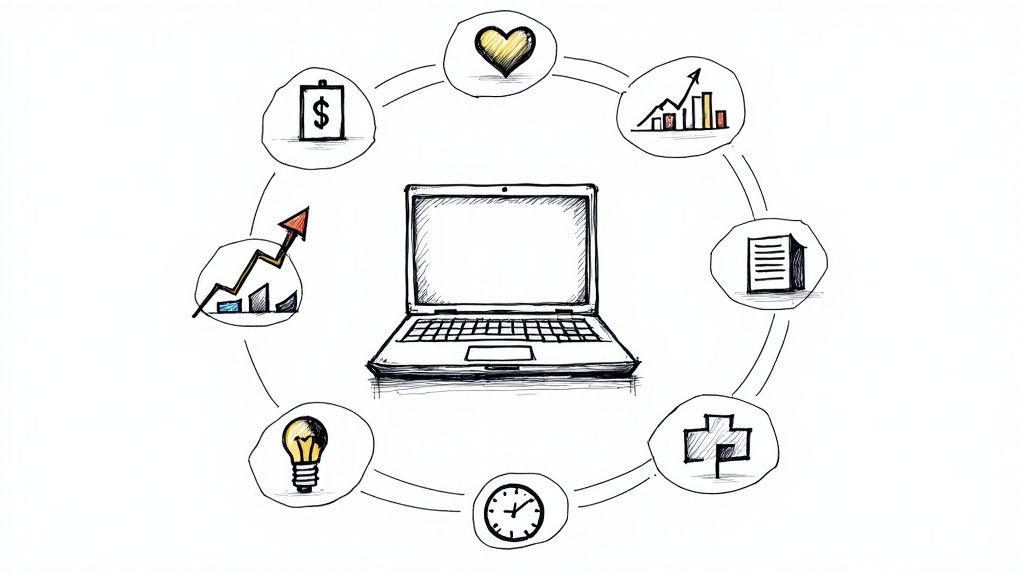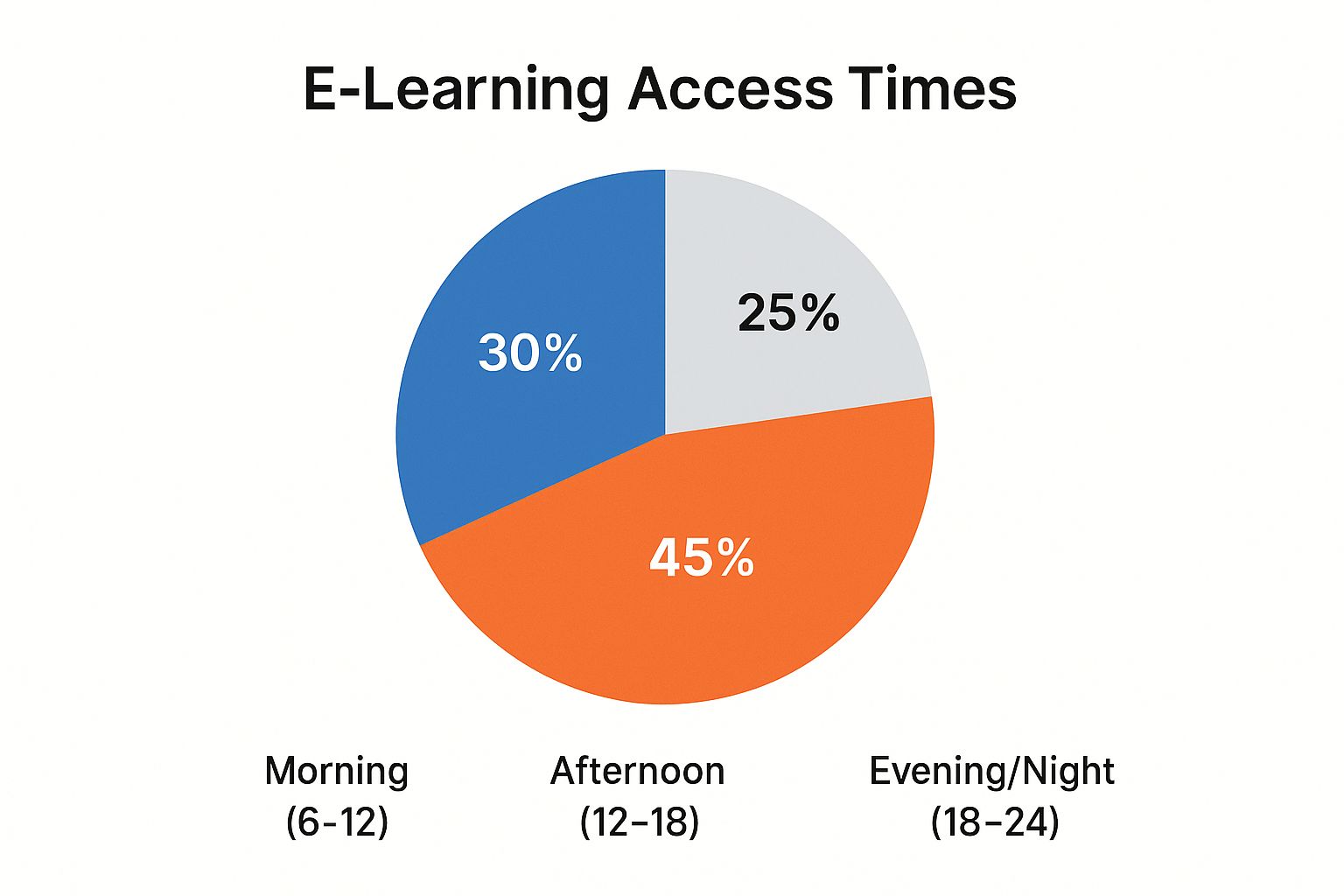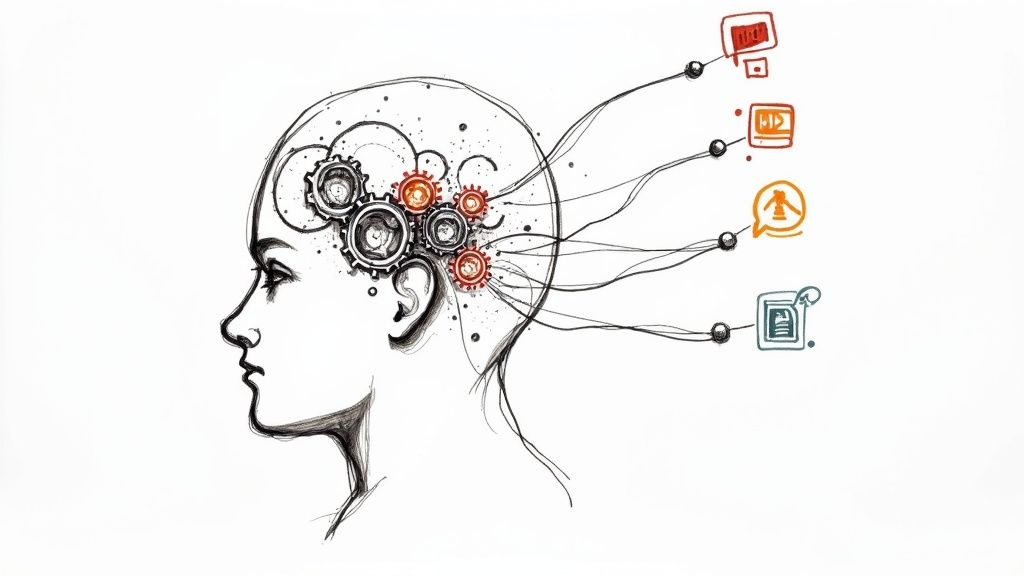
Remember when online learning felt like a static PDF and a clunky, multiple-choice quiz? Those days are long gone. Today's eLearning is a dynamic, intelligent ecosystem that's reshaping how we acquire skills, both in academia and corporate training. The real benefits of eLearning have moved far beyond simple convenience; they now center on the strategic fusion of instructional design theory with robust software like the Articulate Suite or Adobe Captivate, supercharged by innovations like AI-driven personalization and microlearning.
This isn't just about putting content online. It’s about leveraging the latest trends in instructional design to create truly effective and engaging learning experiences. This shift is turning passive content consumption into active skill development, powered by sophisticated platforms like a Learning Management System (LMS) or a Learning Experience Platform (LXP).
In this roundup, we're cutting straight to the chase. We will break down the 8 most impactful benefits of modern eLearning, showing you how today's technology makes them achievable. Whether you're an instructional designer, an educator pivoting your career, or a corporate trainer, this guide will provide practical insights into how these advantages can revolutionize your learning strategy and deliver measurable results. Let's dive in.
One of the most transformative benefits of elearning is the incredible flexibility it offers. This isn't just about letting learners study at 2 AM if they want. Modern flexibility is an instructional design principle brought to life by sophisticated technology like a Learning Management System (LMS) or Learning Experience Platform (LXP).
Today's platforms deliver content flawlessly across any device, from a desktop computer to a tablet or a smartphone. This opens the door for powerful instructional design trends like microlearning, where training is broken down into bite-sized, five-minute modules. An instructional designer might use a tool like Articulate Rise to create a responsive module that a sales rep can quickly review on their phone right before a client meeting. It's learning on-demand, precisely when it's needed most, a core tenet of performance support theory.
Consider a global company using its LXP to deploy consistent training to thousands of employees across dozens of time zones simultaneously. Or picture a working parent pursuing a new certification by completing modules on their tablet late at night after the kids are in bed. This level of access was unimaginable in a traditional classroom setting. It puts the learner in complete control of their educational journey.
The data shows that learning doesn't just happen during a typical 9-to-5 workday. In fact, a significant portion of engagement occurs outside of traditional business hours, highlighting the need for 24/7 access.
This pie chart visualizes when learners are most likely to access their eLearning content throughout the day.

The chart clearly shows that the largest segment of learners, 45%, are logging in during the evening and night, proving the immense value of asynchronous, on-demand training.
One of the most compelling benefits of elearning is its significant impact on the bottom line. Moving training online drastically cuts costs by eliminating the need for physical classrooms, travel, accommodation, and printed materials. This isn't just about saving a few dollars; it's a fundamental shift that makes high-quality education and corporate training more financially viable and accessible for everyone.
Modern learning platforms are designed for efficiency. An L&D department can develop a single course using an authoring tool like Adobe Captivate or Articulate Storyline and deploy it to thousands of employees globally via their Learning Management System (LMS). This avoids the logistical nightmare and expense of flying instructors to different sites. This model replaces recurring costs with a more predictable, often one-time, investment in content creation and platform maintenance.
Consider a company like Walmart, which uses elearning to train its massive workforce on everything from safety protocols to customer service. The cost to conduct that level of training in-person would be astronomical. On an academic level, initiatives like MIT OpenCourseWare and platforms such as edX provide free or low-cost access to world-class course materials, removing financial barriers for millions of learners worldwide.
The financial advantages extend beyond the organization to the individual learner. With no commute, no need to purchase physical textbooks, and fewer associated fees, learners can pursue professional development or higher education at a fraction of the traditional cost. The savings are not just theoretical; they are tangible and immediate. This economic efficiency is a key reason why elearning has become a cornerstone of modern educational strategy.
One of the most powerful benefits of elearning is its ability to move beyond a one-size-fits-all model. Instead of forcing every learner through the same linear path, modern platforms use AI and adaptive algorithms to create a deeply personalized journey. This technology assesses a learner's performance in real-time and adjusts the content, pace, and difficulty to match their specific needs and knowledge gaps.

This adaptive approach, a key trend in instructional design, is often executed through a sophisticated Learning Experience Platform (LXP). An instructional designer can leverage these systems to ensure a new hire isn't bored with familiar topics while a veteran employee receives the advanced training they need. It’s a dynamic, responsive, and efficient way to foster genuine skill development.
This isn't a futuristic concept; it's happening now. Think of Duolingo, which adjusts language lesson difficulty based on your answers, or Carnegie Learning's AI-powered math software that acts as a personal tutor for students. In the corporate world, platforms like LinkedIn Learning provide Netflix-style content recommendations, guiding employees to courses that align with their career goals and demonstrated interests. This technology is a cornerstone of effective competency-based training programs, ensuring learning is always relevant.
Adaptive technologies create a continuous feedback loop that tailors the educational experience. This video provides a clear overview of how these intelligent systems operate to enhance learner outcomes.
As the video explains, the system constantly gathers data on user interactions to refine the learning path, making it a truly intelligent and supportive educational partner.
One of the most powerful benefits of elearning is its near-infinite scalability. Unlike a physical classroom limited by four walls, digital learning platforms can deliver training to ten, ten thousand, or even ten million learners simultaneously without a significant increase in logistical overhead. This allows organizations and institutions to expand their educational footprint globally, reaching audiences that were previously inaccessible.
Modern Learning Management Systems (LMS) and Learning Experience Platforms (LXP) are built on robust cloud infrastructure, designed to handle massive concurrent user loads. An instructional designer can create a single, high-quality course using the Articulate Suite, upload it to the LMS, and instantly make it available to a worldwide workforce. This is how large-scale initiatives like Massive Open Online Courses (MOOCs) became possible, democratizing education on a global scale.
Consider platforms like Coursera, which was born out of Stanford University and now serves over 100 million learners across the globe. Or look at multinational corporations like General Electric, which uses its legendary Crotonville leadership development programs online to train managers in different countries simultaneously. These programs maintain high-quality, consistent messaging while reaching a dispersed audience, a feat impossible with in-person training alone.
Scaling training is essential for any organization experiencing rapid growth, entering new markets, or aiming to standardize core competencies across all locations. It’s also a cornerstone for global initiatives by organizations like UNESCO, which leverages elearning to provide vital educational resources in developing nations. It breaks down geographical barriers, ensuring everyone has access to learning opportunities.
One of the most powerful benefits of elearning is its ability to move beyond guesswork and into data-driven insight. Unlike traditional learning where progress is often measured only by periodic exams, modern elearning platforms offer a continuous stream of analytics. This allows learners, instructors, and organizations to monitor engagement, pinpoint knowledge gaps, and optimize the learning experience in real-time.
Sophisticated Learning Management Systems (LMS) and Learning Experience Platforms (LXP) act as powerful data hubs. An instructional designer can set up a course in Adobe Captivate that tracks not just quiz scores, but also the time spent on each slide and the specific answers chosen. This granular data, a key component of modern instructional design theory, reveals precisely where learners are struggling, enabling targeted support long before a final assessment.
Consider a corporate training department using its LMS dashboard to monitor the completion rates of a new compliance module. They can immediately see which teams are falling behind and offer them additional support. In an academic setting, a language learning app like Duolingo uses data to track daily practice streaks and proficiency levels, motivating users to stay engaged. Similarly, Google Classroom provides educators with instant reports on assignment submissions and grades, simplifying administrative tasks and highlighting students who need help.
This constant feedback loop empowers everyone involved. Learners can see their own progress, instructors can adjust their teaching strategies, and companies can measure the direct impact of their training investments. The ability to collect and analyze this data is a core advantage that makes digital learning so effective. Learn more about the different types of learning platforms on relevant.training.
Beyond just improving learning outcomes, one of the often-overlooked benefits of elearning is its positive environmental impact. Shifting education and training online dramatically reduces the carbon footprint associated with traditional learning by cutting down on travel, physical materials, and the energy consumption of large-scale facilities.
This move toward sustainability is not just a side effect; it's a strategic advantage. Modern Learning Management Systems (LMS) and cloud-based authoring tools like the Articulate Suite are inherently more eco-friendly than printing thousands of binders. Companies and educational institutions can now deliver high-quality instruction while simultaneously advancing their corporate social responsibility and sustainability goals. It’s a powerful win-win for both the learner and the planet.
Consider the impact of a single corporate training event. Flying hundreds of employees to a central location, printing manuals, and powering a large conference center generates a significant amount of carbon. By transitioning this event to a virtual format using an LXP, an organization can eliminate nearly all of those emissions. Similarly, universities like The Open University have reported that their distance learning programs produce up to 90% fewer carbon emissions compared to conventional campus-based courses.
This benefit is particularly powerful for large, globally distributed organizations or educational institutions with a strong commitment to environmental stewardship. Every decision to replace a paper-based exam with a digital assessment or host a webinar instead of an in-person seminar contributes directly to a reduced carbon footprint. As organizations face increasing pressure to operate sustainably, elearning provides a practical and effective solution.
One of the most critical benefits of elearning is its power to deliver perfectly consistent and standardized training. Unlike traditional face-to-face instruction, where the experience can vary dramatically based on the instructor, elearning ensures every single learner receives the exact same high-quality message, curriculum, and assessment. This is a game-changer for compliance, certifications, and brand integrity.
A Learning Management System (LMS) acts as the single source of truth, housing and deploying carefully vetted content created with authoring tools like Adobe Captivate or the Articulate Suite. This means whether an employee is in Tokyo, Toronto, or Tulsa, they are learning the same procedures from the same material. This eliminates the "telephone game" effect where information gets distorted as it passes from person to person, guaranteeing a uniform standard of knowledge.
Think about a global brand like McDonald's and its famous Hamburger University. Its online training platforms ensure that the process for making a Big Mac is taught identically to crew members worldwide, protecting brand consistency. Similarly, professional certification programs for PMP or Cisco networking rely on standardized elearning to guarantee every certified professional has mastered the same core body of knowledge, making the credential meaningful and reliable.
Standardization isn't about stifling creativity; it's about building a reliable foundation of knowledge. For critical topics like corporate compliance, safety procedures, or software rollouts, there is no room for variation. Every employee must understand the policies and procedures in exactly the same way to mitigate risk and ensure operational excellence.
This consistency creates a level playing field, where performance can be accurately measured against a clear, universal benchmark. It’s a foundational element that underpins scalable and effective training strategies.
Beyond simply delivering content, one of the core benefits of elearning is its inherent ability to boost digital literacy. In today's workplace, proficiency with technology isn't just a bonus; it's a baseline requirement. Elearning platforms naturally immerse learners in a digital ecosystem, forcing them to engage with tools and workflows that mirror the modern professional environment.

This isn't just about learning to click through a course made with the Articulate Suite. It's about developing a broader digital fluency. For instance, an employee taking a course on project management within their LMS might simultaneously become proficient in collaborative tools like Slack or Microsoft Teams, learn to co-edit documents in the cloud, and practice professional etiquette in virtual meetings. It’s a two-for-one benefit: they gain the primary knowledge and sharpen the tech skills needed to apply it.
Think about a new hire onboarding process conducted entirely through an LMS. The new employee learns company policies while simultaneously mastering the platform they'll use for all future professional development. Or consider a student in a remote degree program who becomes an expert at navigating video conferencing software, participating in digital forums, and using online research databases effectively. These skills are directly transferable and highly valuable in any career path.
The modern workplace demands more than just job-specific knowledge. It requires a comfort level with a constantly evolving suite of digital tools. Elearning provides a safe, structured environment to build this essential skillset. From understanding how to troubleshoot a basic technical issue to leveraging AI-powered learning aids, learners gain confidence by doing. This digital readiness is a powerful, often overlooked outcome of a well-designed elearning strategy.
We’ve journeyed through the dynamic landscape of modern learning, and the conclusion is clear: the benefits of elearning have transformed from a mere convenience into a strategic powerhouse for growth and development. Moving beyond simple online modules, we've seen how today's eLearning leverages cutting-edge technology to create deeply impactful educational experiences. It’s no longer just about putting a course online; it’s about crafting a learning ecosystem where instructional design theory meets powerful software.
The true magic happens when you weave together the trends we've discussed. Imagine combining the flexibility of on-demand microlearning with the power of an LXP that uses AI to recommend personalized content. This creates a learning environment where employees aren't just consumers of information; they're active participants in their own development, accessing what they need, exactly when they need it. This synergy is where the real value lies.
Understanding these benefits is the first step. The next is implementation. Don't feel like you need to tackle everything at once. Start by identifying your team's most significant pain point.
The key is to think of these benefits not as a checklist, but as a toolkit. By strategically combining these elements, instructional designers and L&D leaders can build a culture of continuous improvement. The data-driven insights from your LMS or LXP analytics provide a powerful feedback loop, showing you exactly what’s working and where to iterate. This is how you move from simply delivering training to demonstrably improving performance and boosting your team’s digital literacy. The modern L&D professional is a strategist, an analyst, and a creator, and mastering these eLearning benefits is fundamental to that role.
Ready to unlock these advantages but need a hand creating content that truly connects? Relevant Training specializes in developing and updating dynamic eLearning courses that leverage the latest instructional design principles to drive engagement and results. Explore our services and let's build a smarter learning experience for your team.